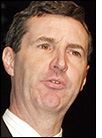Tesco CIO Collin Cobain says his company is looking to expand a yearlong trial in which the British retailer has been tracking the on-shelf availability of DVDs. The company wants to add eight additional stores to the trial, which now involves just two stores. But first, Tesco will shift from its current use of passive 13.56 MHz radio frequency identification (RFID) tags to ultra-high frequency tags.
“We want to use one frequency and one infrastructure through our entire operation,” he said, explaining the switch to UHF tags. Cobain was speaking at the National Retail Federation trade show and exhibition in New York City.
The tags can be hard to read on DVDs, which have an aluminum coating that reflects the RF signals from an RFID reader. But Cobain said this was not a major obstacle. The bigger problem has been getting EPC tags that function reliably and consistently and putting them on the DVDs cost-effectively. Integrating RFID with the DVD packaging has been challenging, and manually placing labels on the jewel cases is expensive.
A little more than one year ago, Tesco began working with MeadWestvaco’s Intelligent Systems division (see Tesco Tests Low-Cost RFID System), which has provided smart shelf technology. Tags are placed on DVDs bound for two stores at the facilities of a DVD distribution company. The DVDs are tracked both in the back of the store and on the shelf.
The stores’ staff gets reports about which DVDs are out of stock and which are in the wrong shelf location. They then replenish the shelf and put items back in the right location. Cobain says that data obtained during the initial trial at two stores indicates that the RFID-enabled shelf increases on-shelf availability by 50 percent.
But Cobain said it’s too early to say how much sales improved as a result of increased on-shelf availability. “Our DVD sales are rising about 35 percent annually in all our stores,” he told RFID Journal. “That makes it hard to compare the improvement in sales [at the two stores with RFID tags on the DVDs] and other stores.”
When Tesco resolves all the issues around tagging DVDs with UHF EPC tags—and Cobain wasn’t sure how long that would take—the company will run tests in 10 stores. Some of those stores will serve as a control for the trial. That is, the RFID technology will be installed to measure on-shelf availability, but the current processes will not change. That way, Tesco will be able to do a direct comparison and determine the effect that data from the RFID system has on sales.
The DVD tests are separate from the company’s use of RFID in its distribution centers and stores. Cobain said that that the technology’s rollout at distribution centers and stores is continuing. The company recently ordered 4,000 readers, which will be installed on all receiving and shipping dock doors at its distribution centers in the United Kingdom and at the receiving bays of some 1,400 stores in the U.K.


